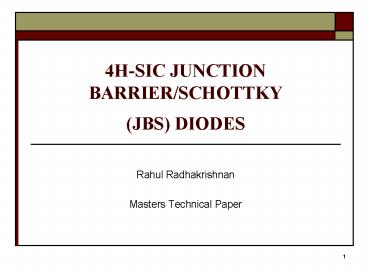4HSIC JUNCTION BARRIERSCHOTTKY JBS DIODES - PowerPoint PPT Presentation
1 / 23
Title:
4HSIC JUNCTION BARRIERSCHOTTKY JBS DIODES
Description:
PIN part limited by fabrication tolerances. PIN part ideally doesn't turn on at low currents ... Fabrication and DC testing were done. SiC material quality bottleneck ... – PowerPoint PPT presentation
Number of Views:266
Avg rating:3.0/5.0
Title: 4HSIC JUNCTION BARRIERSCHOTTKY JBS DIODES
1
4H-SIC JUNCTION BARRIER/SCHOTTKY (JBS) DIODES
- Rahul Radhakrishnan
- Masters Technical Paper
2
Introduction
- Modern power system trends
- Size reduction
- Higher efficiency
- Fast switching devices
- Rectifier
- Low leakage current
- Low on-resistance
- Fast switching
3
Why JBS diode
- Unipolar devices inherently faster
- PIN junction reverse leakage current is lower
- Schottky junction forward resistance is lower
- Junction Barrier Schottky (JBS) diode combines
both - Low barrier schottky
- Predominant schottky action at low forward
currents reduces minority carrier storage - Reverse depletion region of PIN junction expands
laterally to pinch-off schottky junction
4
Silicon Carbide
- High band-gap (3.2eV for 4-H SiC)
- Low intrinsic concentration of charge carriers
- Lower leakage current
- 10-8/cm3 compared to 1010/cm3 for Si
- Large saturated electron drift velocity
- Faster switching
- Small dielectric constant (9.7)
- High thermal conductivity
- High electron mobility
- So, attractive candidate for power
semiconductor!
5
SiC v/s Si JBS diode
- Higher doped drift region
- Minority carrier injection by PIN part is not
essential in SiC JBS diodes. - So, reverse recovery is even better.
- Smaller drift region thickness
- About 10 times higher critical electric field
- Series resistance is thus reduced
- High voltage and current operation
6
JBS technology
- Geometrical arrangement of PIN and Schottky parts
critical - Schottky part carries forward current decides
on-resistance - PIN part limited by fabrication tolerances
- PIN part ideally doesnt turn on at low currents
- Doping and thickness of semiconductor
- Schottky metal
- Overlay metal layers
- Edge termination
- Guard rings
- Junction termination extension
7
JBS theory
- On the left, schottky interface carries forward
current - On the right, the PN junction depletion region
widens to pinch off the schottky channels - Depletion region pinch off only under reverse
bias - Schottky barrier is shielded from applied reverse
voltage by pinch-off
8
Reverse Breakdown
- Critical E-field Avalanche breakdown
- Punch-through breakdown
- 3-D field crowding at real junctions
- Breakdown votage depends on
- Critical field
- Epitaxial layer doping
- Epitaxial layer thickness
- Edge-termination
- Upto 80 of ideal breakdown by Guard rings
- Upto 95 by Junction termination Extension
9
SiC JBS diodes
- First used on Si by Williamovski and Baliga in
1983-84 - High voltage Si JBS later demonstrated.
- Held and Dalquist realised SiC JBS diodes in 1998
- No advanced edge termination
- Later, very good JBS results achieved
- In 2004, J.Wu, L.Fursin, P.Alexandrov and J.Zhao
- 4308V blocking and 20.9m?.cm2 forward resistance
- 30µm drift layer and active area 1.4mm2
10
Device Structure
- n-/n 4H-SiC epitaxial wafer
- 3 types of Devices- 3mm3mm, 4mm4mm 0.6mm0.6mm
11
Fabrication Steps-1
- Wafer cutting, cleaning and alignment mark
formation - Device mesa is about 3000-4000A
12
Fabrication steps-2
- P implantation
- Guard rings as well as PIN regions of MPS
- Post implantation annealing at 1550ºC for 30
minutes
13
Guard Ring Termination
- Many p implanted guard rings separated by
schottky regions - Designed to drop high voltage uniformly till edge
- Electric field minimised
- Right design of guard ring thickness and
separation - Photograph of guard rings under backlight
14
Fabrication Steps-3
- Surface passivation by thermal oxidation and
PECVD - Window opening
- Backside metal ohmic contact (AlTi/Ni)
15
Fabrication steps-4
- Substrate-side ohmic contact with
Ti(800A)/TiW(2500A) - Low schottky barrier height
- Overlay metals
16
Photo- Masks
17
Testing after Schottky contact
18
Schottky metal Annealing
- Various annealing temperatures from 500ºC to
600ºC for upto 1 hour tried. - Annealing improves the Ti/SiC interface contact.
- Best improvement in reverse characteristics
- 550ºC for 20 in presence of inert gas Ar.
- Au (2.5um) is used as the overlay metal, which
decreases the forward resistance by providing a
larger area for the spreading current
19
Testing after Schottky annealing
20
After Au overlay
21
Results
- 7 probes used after final overlay.
- 55A/cm2 at 1.5V and 170A/cm2 at 4V forward
- More than 1.2kV breakdown voltage.
- Yield is lower for bigger devices
22
Summary
- Fabrication and DC testing were done
- SiC material quality bottleneck
- Switching test, high temperature test should be
done - Packaging would further improve forward
performance
23
Thank you!































